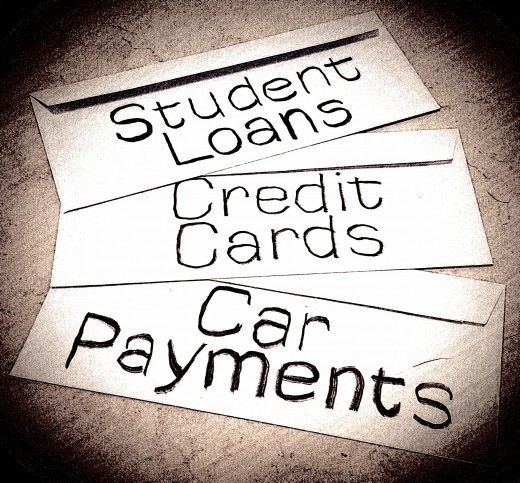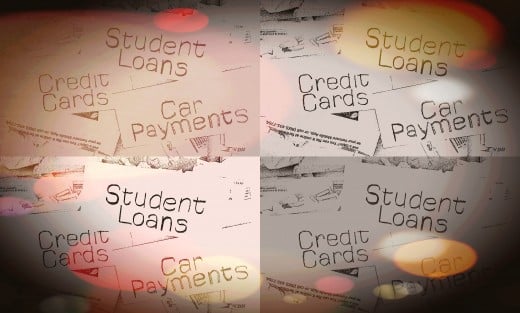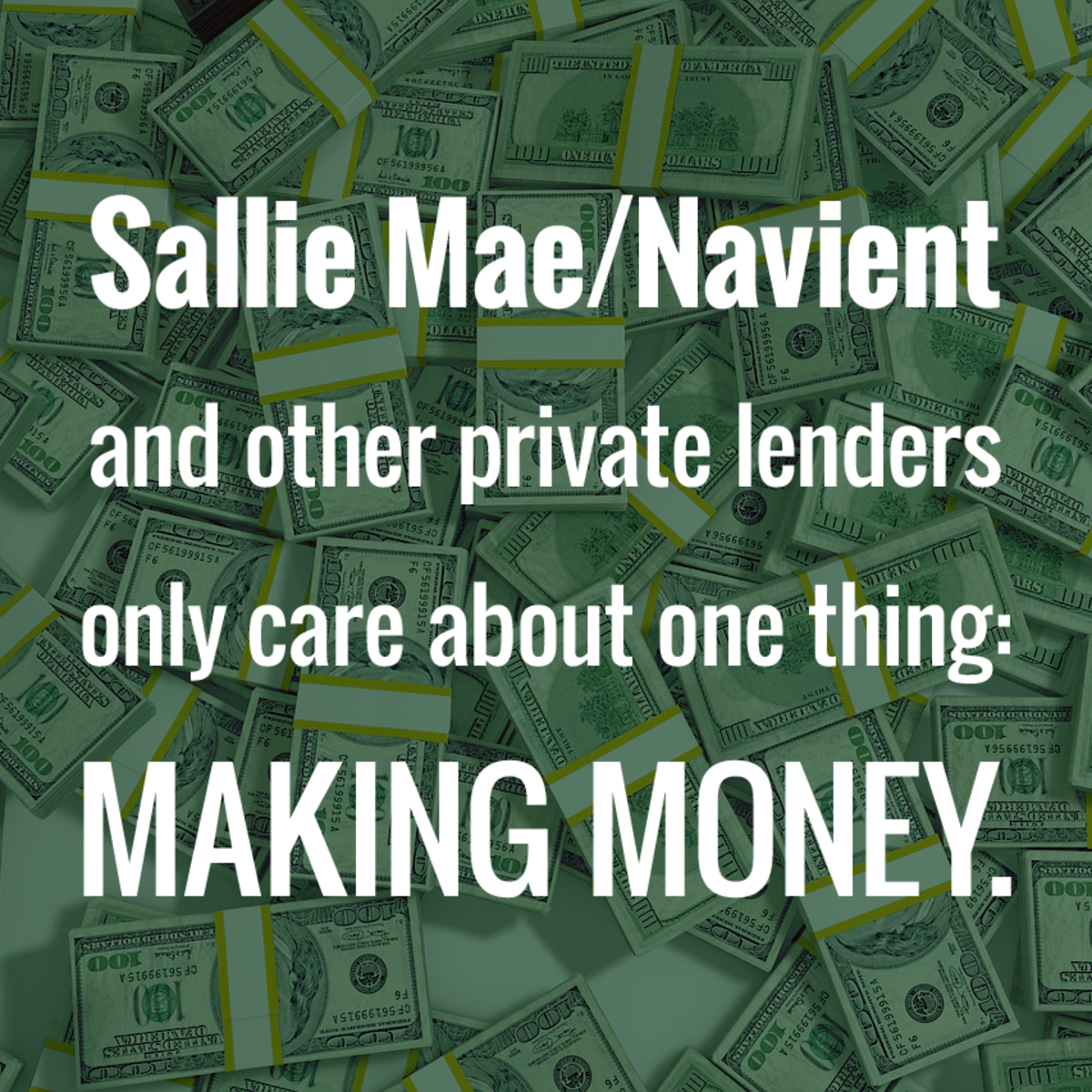All About Federal Loans for Student, Federal Plus Loans, and Stafford Loans
Federal Student Loans
Federal student loans are often necessary when it comes to financing an education. Students and parents have the option of using federal student loans or personal loans. Federal student loans are funded and/or insured by the government whereas private loans are funded by banks or lending companies. Federal loan programs are the primary source of education loans in the United States. The Department of Education manages the two leading programs for federal loans. They are the Federal Direct Loan Program (FDLP) and The Federal Family Education Loan Program (FFELP). The FDLP allows students and parents to directly borrow money from the government. The FFELP loans are funded by state lending agencies but insured by the federal government. In most cases, when a school participates in the FFELP, they will recommend that you use their preferred lender.
Books can cost thousands of dollars

Subsidized vs. Un-subsidized Federal Student Loans
Federal student loans usually fall into two categories, subsidized or unsubsidized. Subsidized loans are granted based on the financial needs of the student and their families. The amount of the subsidized loan is determined by the school. The interest on subsidized loans does not start to accumulate until the repayment process begins. Also, you are not responsible for paying any interest during grace or deferment periods.
Unsubsidized loans charge interest starting when the money is administered. When the repayment period begins, you must pay interest on the interest that has already begun to accumulate. One way to avoid paying so much interest is to pay the interest as it accumulates.
Student loans for higher education
A student loan is a kind of financial aid that must be paid back with interest. One type of student loan or education loan is the consolidation loan. A consolidation loan allows the borrower to combine all their loans into one lump sum, simplifying payment. However, that is just one example of education loans. Education loans are basically divided into these three primary categories:
-Student loans (Stafford and Perkins loans)
-Private student loans (alternative student loans)
-Parent loans
Federally guaranteed loans
A lender may charge any interest rate they wish on federally-guaranteed loans. So long as the rates or falls below or meets the maximum federally set rates. There is nothing preventing lenders from lowering their fees and rates. In fact, many lenders often offer education loan discounts, to attract borrowers.
Statistically only a small percentage of students can afford to pay for college without some sort of financial help. So unless you received a scholarship or a grant you’ll need to find a financial institution that is willing to give you a loan.
Graduating with debt
It is not uncommon to graduate college with some debt. According to the 2003-2004 National Post-secondary Student Aid Study (NPSAS), two-thirds of undergrads graduate with debt. The average federal student loans (Stafford and Perkins) debt among senior graduates is around $19,000 (the median being around $17,000). One-quarter of undergrads borrow $25,000 or more, leaving one-tenth borrowing $35,000 or more. These figures increase to be about 3% (or about $550) a year. When including Parent loans (plus loans) into the equation the average accumulative debt incurred is almost $22,000. About 1 in 10 parents will borrow Parent loans (plus loans) so that their children may get a college education. Such loans usually have an accumulative debt of around $16,000.
Money saving tips & obtaining the right loan

Never get over charges
Federal law sets the maximum interest fee/rate on federally-guaranteed loans that prevent lenders from overcharging borrowers.
Examples of Federal Student Loans
Federal Stafford Subsidized and Unsubsidized Loans
The most common types of federal student loans are the federal Stafford subsidized loan and federal Stafford unsubsidized loan. To be eligible for these loans you must fill out the free application for federal student aid (FAFSA), be enrolled or will be enrolled in school for at least half-time, attend a college that is involved with the Federal Family Education Loan Program, and must not be in default on any other student loans. For graduate and professional students with a subsidized loan, and for all students with an unsubsidized loan, the interest is fixed at 6.8%. The interest rate for undergraduate students awarded a subsidized Stafford loan between July 1, 2008, and June 30, 2009, is 6%. There are loan limits that apply to both Stafford loans. The limits may depend on what year the student is in and whether they are independent or dependent.
Federal PERKINS loan
The Federal Perkins Loan is a subsidized loan with a low-interest rate of 5%. The Perkins loan is granted to either undergraduate or graduate students who qualify as having relatively significant financial needs. After the school receives a specified amount of money from the U.S. Department of Education, they will combine it with their own loan funds and distribute it to students with the greatest financial need. There are fewer fees and a longer grace period associated with the Federal Perkins loan. Unlike Stafford loans, Perkins loan money is borrowed directly from the federal government and the school rather than major lending institutions. Also, students who receive a Perkins loan must prove and maintain specific standards of academic success.
Federal PLUS loan
There are two types of federal PLUS loans, the Grad PLUS, and parent PLUS loan. The federal grad PLUS loan is available to graduate or professional students. The parent PLUS loan is for parents or guardians of undergraduate students. To be eligible for a PLUS loan, the student must be enrolled in school for at least half time. The PLUS loans are awarded on the basis of credit history, not financial need. It is recommended that students and parents exhaust the use of federal Stafford loans, grants, and scholarships before applying for a PLUS loan. The PLUS loans are available to make up the difference of what all other financial aid will not cover. The amount of the PLUS loan an applicant is eligible for is determined by the total estimated cost of all school-related expenses minus all other financial aid already awarded.
Higher education can cost a lot of money

Federal PLUS Loans
There are two types of federal PLUS loans. The parent PLUS loan is for parents or guardians of students who are dependents and attending undergraduate school. The Grad PLUS loan is available only for graduate or professional students. Both loans require that the student is attending school at least half time. These federal loans are considered unsubsidized loans.
In other words, the interest will start to accumulate as soon as the loan is administered. Unlike federal Stafford loans, both federal PLUS loans are credit-based loans and depend solely on the credit rating and credit history of the applicant, not on their financial needs.
Benefits of federal PLUS loans
Although there are many benefits to federal PLUS loans, it is recommended, and sometimes required by schools that the borrower exhausts all federal Stafford loans, scholarships, and grants before applying for a PLUS loan. The parent and Grad PLUS loans have a relatively high fixed interest rate of 8.5% compared to the 6 or 6.8% rate currently applied to Stafford loans. The amount of the PLUS loan an applicant is eligible for is determined by the total estimated cost of school-related expenses minus all other financial aid already awarded. For example, if the school estimates the total cost of attendance for one year to be $30,000 and you receive $15,000 in Stafford loans and/or other financial aid, the most you may receive from a PLUS loan is the remaining $15,000. All school-related expenses may include but are not limited to tuition, room, and board, travel, books, and computers. Other unique benefits of the PLUS loans are that no collateral is necessary, interest may be tax-deductible, and many times the government will reduce certain fees for eligible borrowers. Such fees may include a .25% interest rate reduction if an automatic payment plan is used. No cosigner is needed for the Grad PLUS loan unless there is a history of credit difficulties and students always have the option to claim deferment and/or forbearance during times of financial hardship.
Repayment of federal student PLUS loans
Parents with a PLUS loan have the opportunity to make payments while their child is in school or can defer payment until graduation. There are never any penalties for early payments. When it comes time to pay back federal PLUS loans, students and parents have several different repayment options. The most common repayment plans include the standard plan, where you pay a fixed amount each month based on the accumulated interest and the amount borrowed. The graduated plan includes a monthly rate that increases over time. This is based on the interest rate, the amount of the loan, and the assumption that your salary will increase over time. The income-sensitive plan offers monthly payments that are dependent on the borrower’s annual salary and the total loan debt. The extended repayment option is for those who want to extend the repayment process for up to 25 years. Like other federal student loans, a consolidation is also a repayment option that can lower monthly payments by stretching them out over a longer period of time. A minimum of $20,000 in federal PLUS loans must have been taken in order to become eligible for PLUS loan consolidation. The downside to consolidation is that the longer the repayment process, the more money that is paid on the accumulated interest. However, some borrowers may be eligible for a lower interest rate of 8.25% after consolidation. With a parent PLUS loan, parents are required to start repayment between 60 days and 6 months after the student has stopped attending college. Students are sometimes expected to start paying off their grad PLUS loan at the end of the month in which they graduated. Different lenders may offer different repayment plans so it is important to research all the details prior to applying for a federal PLUS loan.
The cost of a higher education can really stack up quickly

How to apply for Stafford Loans
Stafford Loans may be obtainable by completing an application provided by Federal Student Aid (FSA). When applying for both Stafford Loans and Federal Perkins you will not be required to fill out to separate applications. But, you will need to sign a promissory note and a legal document that states you agree to pay your loans according to the terms noted. Be certain to carefully read and understand this note and always keep a copy in a safe place.
Overview of Student Loan Consolidation
Student loan consolidation is a student loan repayment option that involves combining several or all student loans into one. Many times multiple loans such as federal or private student loans are needed to finance an education. Depending on the types of loans granted and the various lenders involved, a borrower may be eligible to consolidate student loans into one monthly payment. Student loan consolidation may not be right for everyone, but it can offer great benefits for qualified borrowers.
Stafford Loan Allowance
When using a Stafford Loan the amount you can borrow depends on a few things, what year you’re in school if you are a dependent student, and whether you receive subsidized or unsubsidized Stafford Loans.
Subsidized Stafford Loan
If you are able to provide information showing that you are in financial need, you can borrow a subsidized FFEL or Direct Loan. A subsidized loan will cover some or all of that financial need (subsidized loan amount may not exceed your financial needs).
The United States Department of Education will pay your subsidized loan interest for half the time you are in school, for the initial six months after you complete school, and during periods of loan payment postponements.
Unsubsidized Stafford Loan
It is possible to receive loan funds that surpass your subsidized loan limits, even if you are unable to show financial need. These types of loans are known as unsubsidized loans.
With an unsubsidized loan, you are responsible for the interest accrued throughout the duration of the loan and until it is paid in full. There is a couple of ways that you may choose to pay your loan interest. You can pay the interest as you go (pay interest and principle at the same time) which will require higher monthly payments but saves you money in the long run. You may choose to allow the interest to accumulate by paying principal only thus lower monthly payments. This payment method, however, is not recommended because it will definitely cost the borrower more money in the end.
You are allowed to receive subsidized and unsubsidized loans for the same enrollment period, so long as the combination doesn't exceed the annual loan limit.
Subsidized and Unsubsidized Loan Limits
The amount you can borrow will be less during periods of study shorter than an academic year. If you receive other financial aid that is used to covers a portion of the cost of attendance, you could receive less from your subsidized or unsubsidized loans.
Your chosen academy can refuse to certification of your loan application, so long as they provide a written explanation. The school may also certify a loan for an amount less than what you otherwise would be eligible to receive. If your school certifies an amount less than what you qualify for, they must provide a written explanation of why such action was taken. The school's decision is always final and cannot be appealed to us.
Stafford Loans will come with some additional charges other than the interest. You will also be charged a fee of up to 4% of your loan, which will be deducted proportionately from each loan disbursement. Do to this deduction the actual amount you receive will be less than the amounts you are borrowing.
The loan money must first and foremost be used to pay your tuition, fees, and housing. You will receive any remaining funds either by cash or check. You have the option to allow the school to retain the funds for future academic use.
Call 1-800-4-FED-AID if you have any additional questions about Stafford Loans.
Consolidate your loans & save money

Benefits of student loan consolidation
There are several benefits student loan consolidation may provide. When beginning the repayment process, a person will probably have to pay different rates of interest for different loans. Often, consolidation allows for one, lower, fixed interest rate. The interest rate on the consolidated loan is dependent on the present rates of the existing loans and the repayment plan that is chosen by the borrower. Most of the time, the interest rate is determined by the weighted average of the interest on the existing loans. There are online tools, such as a student loan consolidation calculator that will estimate what the final interest rate will be. This interest rate will remain fixed for the entire life of the loan. Student loan consolidation also allows borrowers to make payments to one single lender instead of several different lenders. This makes repayment more convenient, manageable, and organized. In many situations, loan consolidation allows for a lower monthly payment. This will simplify the payment and make the financial burden much easier to understand and manage and therefore will probably avoid the unnecessary accumulation of interest. Although student loan consolidation may offer various benefits, research should be done due to so many unique individual financial situations.
The downside of student loan consolidation
There are many important factors to consider when deciding whether or not to consolidate student loans. Lending institutions may claim that consolidation will save you money, but most likely you will be paying a larger sum of money over a longer period of time, even though the monthly payments may be smaller. Although this may be ideal for some borrowers, this isn't the perfect plan for everyone. Also, the interest rates of your existing loans may be smaller than the consolidated rate and depending on the financial institution, there may be specific or hard to meet criteria that are required to be eligible for student loan consolidation. It is necessary to investigate all the details before a decision is made.
When to consider student loan consolidation
It is best to consider student loan consolidation at the start of the repayment process. If you consolidate at the beginning you avoid accumulating interest and more of your payments will be applied to the principal. If possible, make extra payments. The longer the repayment period takes, the more you will pay in interest.
Student loan consolidation repayment plans
There are four common types of repayment plans that students and parents can choose from. They are as follows:
#1
Standard Repayment Plan: This plan includes a fixed monthly payment for up to, but no longer than 10 years.
#2
Graduated Repayment Plan: This plan allows for lower monthly payments at the beginning of the repayment process and then after, usually 2-5 years, the payments will increase due to the likelihood that salary will also increase. This plan requires that the loan be paid over ten years.
#3
Extended Repayment Plan: This plan includes a fixed monthly payment that can be paid over 12 to 30 years. The length of this repayment process depends on the amount of money borrowed.
#4
Income Contingent Repayment Plan: This plan includes monthly payments that are determined by the borrower's income, family size, and the amount needed to be repaid. This plan can pay over for up to 25 years.
Easy Student Loan Consolidation
The decision of whether to consolidate student loans may look like a no-brainer to most, but truly the choice to use student loan consolidation is really up to the borrower. When looking at the choice to consolidate, a few questions must be asked and answered.
So many loans and bill can make you feel overwhelmed, it may be time you get help!

So many loans! What can students consolidate?
The first rule of thumb to remember when it comes to student loan consolidation is to never mix federal and private loans! This is important because one cannot put private loans into federal loan consolidation. Another reason is if students put federal loans into a private consolidation loan, they would lose all the low-interest benefits. The best way to keep all the loans into proper consolidation is to approach federal loans first. When those have been properly put into a federal student loan consolidation, then it is safe to tackle the private loans. Keeping organized is the most important aspect when working with financing as it can affect students for the rest of their lives.
When borrowers are ready to look at student loan consolidation, they have to be out of school. Unfortunately, any loan that borrowers use while they are still taking classes can not be rolled into the consolidation loan. But when students graduate and enter into their six month grace period, or if their daily attendance slips below what can be considered half of the full time, or if they no longer attend at all, then it is the time to consider consolidation. A good idea to remember concerning the six month grace period is the fact that if borrowers are still in that window, whatever they student consolidation loan they use federally is going to have a reduced interest rate. This is very helpful to borrowers who are just finishing their educational careers.
The last few pointers to keep in mind concerning student loan consolidation are what to look for in a loan. Students need to ensure that whatever lender or loan program they are going to consider they need to research it first! They can ask for flexible payment options as well as the time period by which they need to pay the amount back. Students also need to ensure that if they want to pay back the consolidation loan early, there will not be any heavy fines attached to early payment. Another pointer to keep in mind is that students may consolidate a loan, even if it is already a consolidation loan. And last but not least, being able to send off one check to one lender, instead of having a notebook full of addresses and lenders, can relieve a lot of stress. Something anyone, not just college graduates, can appreciate is student loan consolidation.
This article is accurate and true to the best of the author’s knowledge. Content is for informational or entertainment purposes only and does not substitute for personal counsel or professional advice in business, financial, legal, or technical matters.
© 2019 Jason Nicolosi








